Blue and grey is not the same
The gene for color dilution (blue dilution),
effect and side effect
|
|
This gene for color dilution is by
no means an invention or a mutation of the " modern times " in the pedigree
dog breed, it existed as can be prove already since that 17. Century in
Europe, at almost all dog races, in some is interpreted it as " standard
color ", speaks it took place thus a pure breed on these, admitted
distinctive color, which isabell colour in the standard as blue (Great Dane/Whippet)
silver-grey (Poodle/Weimaranian), blue blue-& tan/grey tan/grey-& tan (DO
Khyi / Dobermann/Pin), blue/grey (DO Khyi/Whippet) deer-mouse-grey (Weimaranian)
or also (Setter/Dobermann) are designated.
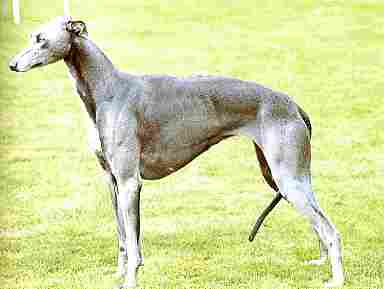
"blue" Greyhound with yellow eye |
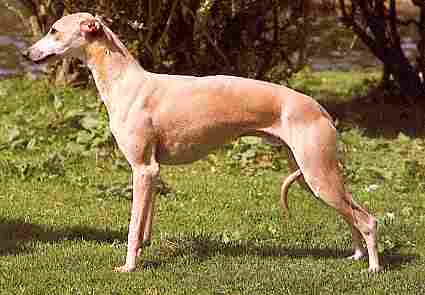
"Isabellcoloured" Whippet, yellow eye |
At other races again (shorthaired
in particular) the color than blue dilution (in the meantime also Dobermann
/ Pin) is excluded.
The color comes off by the effect "
Dilution gene " for blue dilution which received the letter symbol " dd "
from Little and Jones (1919 . Its allele the gene " DD " causes an
intensive, " dd " against it weakened pigmentation. The two genes cause
actually no color, it affect only the intensity of the color, those by other
Genloci are formed (e.g. BB = black, bb = brown).
Opposite " D " " d " behaves simply
rezessiv, i.e. a dog with the formula " BBdd ", which black pigment forms,
appears now under the effect of " dd " " blue ", for example blue Great
Danes, blue Whippets, Silverpoodles, also the Do Khyi... etc.. If the dog
forms however brown pigment, then " dd " causes the characteristic e.g..
Weimaraniancolour, which called Little 1957 " silver deer color " or in
addition, when " isabell solour " one designates.
|
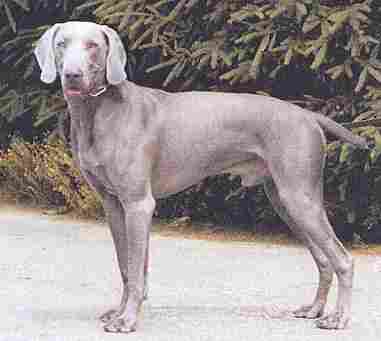
"Silvermicegrey" Weimaranian |
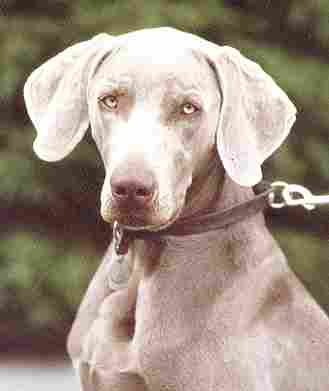
"Silverdeercoloured" Weimaranian |
The colors diluting
effect of " dd " affects itself not only in the hair, but also in
pigmentation of the nose and the eyes. Dogs with the formula of " dd " have
therefore a " slate-grey " nose crest and yellow-brown eyes; here however
also no rule without exception, with the Collie dogs of the formula of " dd
" are born with a black nose. The lightening effect extends, like said above
to the color formed by other Genloci, so for example also on Black and Tan.
In the year 1631 a
picture, which Rupert v. Pfalz with a silver-grey dog represents painted van
Dyck. The picture shows that the silver-grey color already in 17. Century
with managing dogs occurred and to produce that it by no means a crossing of
races required around these. Because the clarification factor, as
represented above, in relation to the intensification factor rezessiv holds
back, knew the color only on the way of a skillful in-breeding as standard
color strengthens, whereby was to be noted that the clarification factor
leads with continued in-breeding to a bad skin formation and susceptibility
for skin diseases, as this already noticed Strebel (1904).
|
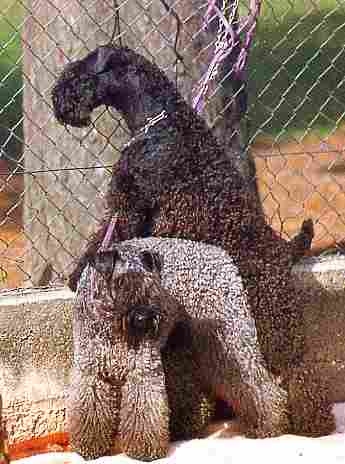 |
Kerry "blue" Terrier, genetical
grey-factor -
without co-operation of the "d" Dilution gene for
Blue dilution
standin in front -simply heterozygot
put up - grey-factor is missing =black
|
|
|
Genotypical different than the " blue " are the " grey " dogs. Their color
is caused by a having a grey factor. Dogs with this factor are always black
born and have always a black nose. It grey in the first or second age more
or less strongly. Modifying factors can cause a completely different having
a grey factor, them hand from the dark ashgrey to a bright silver-grey (e.g.
Kerry Blue Terrier). Because the factor for the having a grey factor leaves
itself dominant, genetically three types can occur: 1. Dogs, which double
the factor, therefore homozygot; 2. Dogs, with which it is heterozygot put
on only simply, therefore and 3. Dogs, with which the having a grey factor
factor is missing. In 1. and 2. the dogs more or less strongly grey width
unit a skin (coat) in the 3 get case. Case remains the skin black.
|
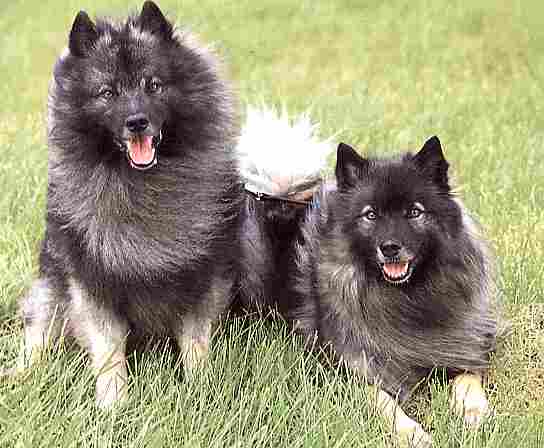
"wildcoloured grey" Wolfspitz |
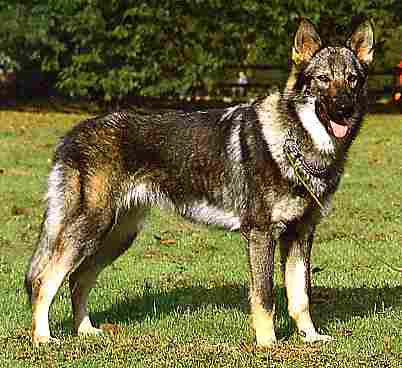
"darkcoloured sabled" Tschechischer Wolfhund |
Completely different
hair color is " dark grey shaded " or also " agouti grey " at different dog
races (e.g. German shepherd dog). Here the individual hair of the " wolf
colouring " is pale-grey-yellow, nearly whitish at the root; pale-yellow a
transition follows this over red-yellow and red to black. The black is
produced by increased, red by decreased storage of the coloring material
melanin, pale-yellow held for the natural color of the hair cells (Raeber,
Strebel, Stephanitz), with further purebreeding appears the color Black and
Tan, which represent an exaggeration of the natural game colouring badges.
The hereditary course for " wolf colors grey " is homozygot rezessiv.
Which
genetics comes with the grey (blue) skin color of the DO Khyi to carrying,
over it Siber (1897) in the summary of the work " the Tibethund " already
writes. Here he mentions, due to descriptions of travelers:
" also " blue " with Roth (slate
grey) might occur here and there "
and it points out with the fact
that the color dilution gene already in the Tibet of the 18.Jahrhunderts,
even if with individual Do Khyi could be observed rarely so however
nevertheless. Likewise the Isabell colour as well as lightyellow eye color
in its work mention finds.
Ann Rohrer describes the more exact career/development of the Dilution gene
" dd" in the breed of the Do Khyi in today's Europe and America:
" a further dog from the second
throw Kalu x Kipu, Langtang Su Chen Chung was exported to the TM owner
Manfred Boese in Germany. From the mating with its male, the blue and tan
coloured German champion Tü Bo does brought Su Chen the splendourful Yidam
Aksu to the world. In the year 1982 Aksu was mated with their father Tü Bo,
which was imported from the Saipal kennel by Mr. Jay Singh in Kathmandu,
Nepal to Germany. From this throw three puppies were imported to America;
Yidam Sindar Dokyi Dragonsquest and Yidam Dakas Kashmir became parents of
further champions in the USA ".
Yidam Dakas Kashmir
* 1982
(Tü Bo x Yidam Aksu) |
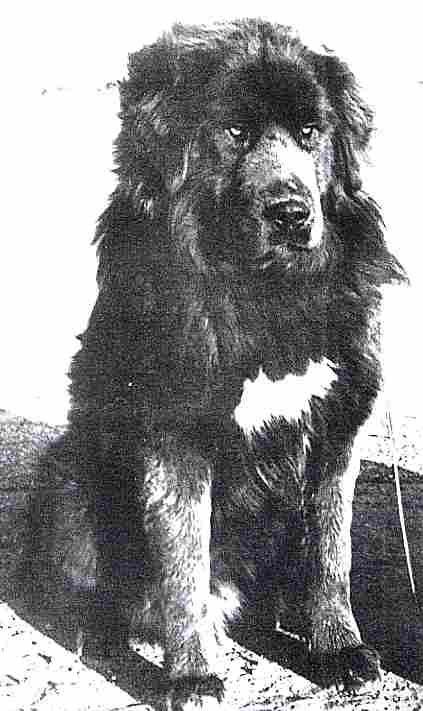 |
Over these
descendants Cathy Flamholtz in their book writes:
" Sibers memory of the blue
color is very interesting. For years this color was unknown with the
American breeders, then the color in a throw of imported parents appeared.
Such a " blue " dog fell in Karen and Rob of pickels breed with the German
import Yidam Dakas Kashmir x Langtang Shay Ri's Sugarfoot. Very interesting
that Siber back-reminds us of this color in the year 1897 ".
In the European
breed of the Do Khyi are the descendants from the throw mentioned above,
Yidam Amban and Yidam Akbar as well as Aksu to pursue in addition, Grey King
(Desääl in almost all geneological tables back and thus might be present the
rezessive Dilution gene " dd " with the Genloci of very many race
representatives. It is thus no coincidence, if two obviously black and/or
black and tan colored parents have suddenly grey (blue) puppies in the throw;
Both are in this case carrier of the Dilution gene " dd ", even the number
of grey (blue) puppies in the throw state nothing over the leaving strength
for this gene with one of the two parents animals. It can quite occur that
coincidentally no grey (blue) puppies lie in such a throw. The calculated
proportional portions with certain combinations of the Genloci of parents
are only statistic values.
|
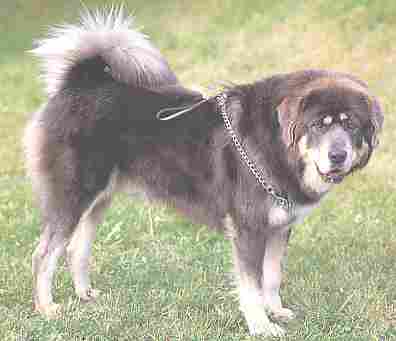 |
"blue & tan coloured"
Do Khyi
( even called "grey & tan" ) |
|
Side effects Dilution gene " dd " or Colour mutation
Alopezie
Already Strebel in its book (the German dogs 1904) describes the effects of
the Dilution gene " dd ", likewise its rezessives behavior:
" straight line as with the
Albinism gives it also with the Melanism a diseased condition (mutation) and
that is the brown or grey (blue) becomes; the first arises with bright eyes
and flesh-colored nose, without transition completely suddenly. With St.
Bernards I have the mask will suddenly see blue, how with dutchman cows
suddenly blue-white piebalds arises. Both kinds thus blue like brown are to
be made constant by the breed, only it noticed to me that the blue hair
color leads with strong in-breeding of the more frequent to the nakedness ".
Strebel describes
here already very early the consequences of an in-breeding with the Dilution
gene carriers of " dd ", which is called today " Colour mutation Alopezie ".
There are quite various causes for Alopezie (= baldness, alopecia), which
can be acquired genetically in addition. In a French book over the Do Khyi
is described the Colour mutation alopecia as completely rare illness of the
grey (blue) Do Khyi, whereby after newer realizations this can occur also
with normally colored animals after in-breeding for many years on Genotypes
of the " dd " with back crossing on normal colors (s. standart Dobermann).
The distinction
of other congenital or acquired causes of the alopecia results in the
clinical picture as well as a biopsie in the sense of the elimination of
other causes.
So far such alopecia
or also different skin diseases is in the German breed (over immune defense
defects - one does not exclude Demodex canis once), thus such congenital or
tardiert illnesses due to the blue color yet arisen (so far well-known), yet
should the observations of the cynologists attention be dedicated and an
in-breeding on the dilution gene " d " by means of employment two " dd "
carrier, thus phaenotypical grey (blue) parents animals be avoided.
|
|
Sources: Raeber, encyclopedia of the pedigree dogs; From the wolf to the
dog, brevier of modern dog breed
Strebel, the German dogs
Stephanitz, the German shepherd dog in word and picture
*
Vanderlip, dog breed, therapy genetics
Dr.Gerhard Schüler, the large Dobermannbook
|
|
Ruth Reheuser 01/2001 |
|
|
|
back
up
|

|
![]()








